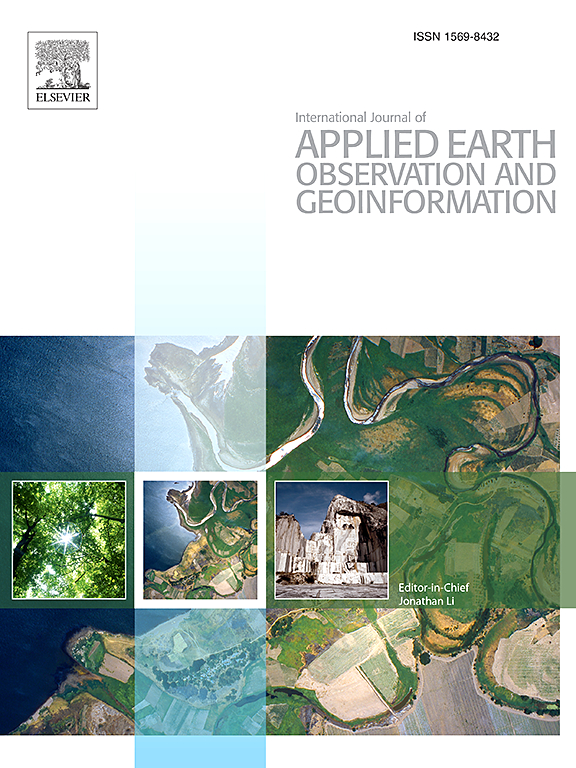通过遥感图像和地理先验生成感兴趣的多模式城市地区
IF 7.6
Q1 REMOTE SENSING
International journal of applied earth observation and geoinformation : ITC journal
Pub Date : 2025-02-01
DOI:10.1016/j.jag.2024.104326
引用次数: 0
摘要
城市兴趣区(AOI)是指具有明确多边形边界的综合城市功能区。城市商业的快速发展导致对高精度和及时性 AOI 数据的需求不断增加。然而,现有的研究主要关注用于城市规划或区域经济分析的粗粒度功能区,往往忽视了 AOI 在现实世界中的应用。它们无法满足移动互联网在线到离线(O2O)业务的精度要求。这些业务要求 AOI 边界精确到具体的社区、学校或医院。在本文中,我们提出了一个完全端到端的多模态 AOI TRansformer(AOITR)模型,旨在同时检测精确的 AOI 边界,并利用遥感图像结合地理先验验证 AOI 的可靠性。与传统的 AOI 生成方法(如在不同层面分割道路网络的道路切割法)不同,我们的方法与依赖于像素级分类的语义分割算法不同。相反,我们的 AOITR 从选择特定类别的兴趣点(POI)开始(可通过网络爬虫轻松获取),并利用它检索相应的遥感图像和地理先验信息,如入口 POI 和道路节点。这些信息有助于建立一个基于变压器编码器-解码器架构的多模态检测模型,以回归精确的 AOI 多边形。此外,我们还通过级联网络模块,利用来自人员流动、附近 POI 和物流地址的动态特征进行 AOI 可靠性评估。实验结果表明,我们的算法在 "交集大于联合"(IoU)指标上取得了显著改进,大大超过了之前的方法。此外,AOITR 生成的 AOI 极大地丰富了我们的 AOI 库,并已成功应用于 10 多个不同的 O2O 场景,包括支付宝的扫脸支付服务。本文章由计算机程序翻译,如有差异,请以英文原文为准。
Multimodal urban areas of interest generation via remote sensing imagery and geographical prior
Urban area-of-interest (AOI) refers to an integrated urban functional zone with defined polygonal boundaries. The rapid development of urban commerce has led to increasing demands for highly accurate and timely AOI data. However, existing research primarily focuses on coarse-grained functional zones for urban planning or regional economic analysis, and often neglects AOI’s expiration in the real world. They fail to fulfill the precision requirements of Mobile Internet Online-to-Offline (O2O) businesses. These businesses require AOI boundary accuracy down to a specific community, school, or hospital. In this paper, we propose a fully end-to-end multimodal AOI TRansformer (AOITR) model designed for simultaneously detecting accurate AOI boundaries and validating AOI’s reliability by leveraging remote sensing imagery coupled with geographical prior. Unlike conventional AOI generation methods, such as the Road-cut method that segments road networks at various levels, our approach diverges from semantic segmentation algorithms that depend on pixel-level classification. Instead, our AOITR begins by selecting a point-of-interest (POI) of specific category, which can be easily obtained via web crawler, and uses it to retrieve corresponding remote sensing imagery and geographical prior such as entrance POIs and road nodes. This information helps to build a multimodal detection model based on transformer encoder-decoder architecture to regress the accurate AOI polygon. Additionally, we utilize the dynamic features from human mobility, nearby POIs, and logistics addresses for AOI reliability evaluation via a cascaded network module. The experimental results reveal that our algorithm achieves a significant improvement on Intersection over Union (IoU) metric, surpassing previous methods by a large margin. Furthermore, the AOIs produced by AOITR have substantially enriched our AOI library and have been successfully applied on over 10 different O2O scenarios including Alipay’s face scan payment service.
求助全文
通过发布文献求助,成功后即可免费获取论文全文。
去求助
来源期刊

International journal of applied earth observation and geoinformation : ITC journal
Global and Planetary Change, Management, Monitoring, Policy and Law, Earth-Surface Processes, Computers in Earth Sciences
CiteScore
12.00
自引率
0.00%
发文量
0
审稿时长
77 days
期刊介绍:
The International Journal of Applied Earth Observation and Geoinformation publishes original papers that utilize earth observation data for natural resource and environmental inventory and management. These data primarily originate from remote sensing platforms, including satellites and aircraft, supplemented by surface and subsurface measurements. Addressing natural resources such as forests, agricultural land, soils, and water, as well as environmental concerns like biodiversity, land degradation, and hazards, the journal explores conceptual and data-driven approaches. It covers geoinformation themes like capturing, databasing, visualization, interpretation, data quality, and spatial uncertainty.
 求助内容:
求助内容: 应助结果提醒方式:
应助结果提醒方式:


